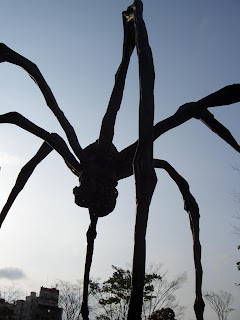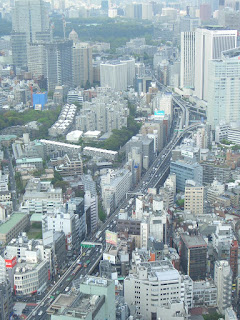The reason I have been down recently is because I have been spending a lot more time alone. I normally talk to Yan in the evenings but he is now going out a lot instead so is home less often. I last mentioned Yan when I went to the Ghibli Museum but I’ll take this moment to give you a proper profile of him. His real name is Woo Churl, he is from South Korea and moved here last November. He is staying in Japan for a year, working in a restaurant to practice his Japanese (which he is fluent in) and teaching himself English at home. He works from nine in the morning till six at night and we used to hang out in the late evening. This week though he has been out till 12 most nights and I find myself sitting around twiddling my thumbs. He has Thursdays off and on Wednesday night we agreed to meet up the next day. I was home from school at 2pm but Yan did not emerge from his room till 9pm because he had been asleep all day due to being ill.
It was on that day that I resolved to change my ways. I realised that I was too reliant on the people here, especially Yan, for company and that I should make more effort to entertain myself. In other words, “For Christ’s sake (sorry to use the lord’s name in vain but at least I capitalised it) you are in Tokyo, stop sitting alone in your room,” I told myself. I looked through my Lonely Planet guide to Tokyo and decided to go to Ropongi Hills the next day, and that’s what I did.
Ropongi Hills is a posh, impressive, modern, zanny new complex in Ropongi. That sentence was vague because the place itself is vague. It is a massive shopping area, a huge tower called The Mori Tower, a small but beautiful garden, hundreds of restaurants, apartments and finally what I came to see. Mamma:

Mamma is an enormous spider, and we are not talking about a Charlotte’s Web personification of a spider here, this is a realistic depiction of a spider because it is monstrous.
Now I hate spiders, which is why I wanted to come and see Mamma because it was clearly built by someone who feels the same way. Spiders build traps then lurk waiting, they tie up their prey to let them die slowly, the mothers eat the fathers, the young eat their mothers (well some types) they are plain evil and so is Mamma.



There is even an egg sack.

Mamma becomes less monstrous when you see how many people walk right passed without batting an eyelid. I guess you can get used to walking passed anything after a while.
So after school and after lunch I hoped on a train to go to Ropongi. I had my guidebook with me but I also had Ian because he lives in Ropongi. Just outside the appropriate station is the Mori tower which has an observation deck on floor 53 and we decided to pay the 1500 yen to go have a look. The view at the top is like this (but bigger and less square).




I have to say that the tower really does shake quite a lot in the wind, I felt a bit sick looking down at the ground far below. Apparently though, if a building shakes normally it’s a good sign
because it is more able to cope with earthquakes. For Ian the view was a, “I can see my house from here,” situation, made easier by his living in a top floor sprawling apartment complete with terrace (his parents own it).
The last time I was at the top of a skyscraper in Japan I was surprised to see shops selling Kermit the frog. This time there was a whole art gallery. The current exhibition at the top of the Mori Tower is on the subject of laughter and begins with two and three thousand year old clay statues of people and animals with smiles on their faces.
Is it just me or do you also find yourself thinking, “Would I buy that?” or “Would I put that in my house?” when you look around galleries. It probably says something awful about the commercialised world we live in these days but by god there was a statue of a smiling horse that I wanted. It was 3000 years old but I was looking for a price tag. I guess everyone feels like that otherwise there wouldn’t always be a shop right next to the exit; it’s like Ikea, you walk around on a set path looking at the showroom bit and then choose what you want to take home at the end.
The displays became more modern with some Japanese screens, one of which was of a smiling tiger gently lapping up water from a stream. The tiger had a cartoony expression on its face: big eyes looking cheekily at something far off to one side, which would have been on an adjoining screen now lost. I realised then that in most olden paintings no one ever smiles. Think about all the portraits of people hanging in stately homes, pictures of everyone from Henry the Eighth to Darwin, they all look miserable. This could well be reflective of what artists are like as opposed to photographers. The expression “cheese,” or “cheesu,” as the Japanese say, sums it up. You only need to raise a smile in someone for a split second for a photograph. Of course good photographers have a better repertoire of quick smile bringers than your standard “cheese” but they are not the kind of thing you will be smiling about for yeas after. There is probably a book of quick quips or something for photographers to learn the art.
Now compare that to artists, who can often be prudish miserable creatures which is fine, because if they were like photographers then they’d have to keep someone smiling for 10 hours or so by saying “come on, give us a smile, that’s it lovely.” And besides, not even an air hostess hostessing a plane of hostesses going on an air hostessing course could keep a smile up that long. There’s a tongue twister in that somewhere.
In summary, I think with the invention of the camera came also the smile to art. But it took a smiling tiger on a 300-year-old Japanese screen to make me realise that.
One of the best displays there was also the biggest, it was about 8 metres by 5 metres but completely flat as it was lying on the floor of a large room. Imagine a big map with green land and blue sea drawn on representing different fictional countries. Decorating the landscape were real objects like plastic trees, buildings and animals. The stars of the show though were about 100 GI Joe wind up toys crawling along randomly. In case you need reminding, GI Joes are classic American boy’s toys; plastic soldiers that crawl forwards by shuffling their legs awkwardly. These GI Joes were all in suits rather than dressed as soldiers and so looked very much like businessmen.
So what happens when you have 100 GI Joes crawling about an enclosed area? Well mostly they end up forming big groups, rival factions that all struggle onwards together. Some had run out of juice and just lay limply, others were crawling against their dead comrades or going nowhere stuck behind buildings. There were different nationalities of GI Joes too; Asians, Americans, Africans etc. The piece was about the world of business, the way that armies of businessmen across the world spend every day competing against each other, forming factions and bravely soldiering on, even if they don’t actually achieve anything.
The lift from the bottom floor to the top of the Mori Tower has a large square panel on its ceiling which acts as a light. When you get into the lift at the bottom is looks like a standard bright white light. But, as the lift rises to the top of the tower the light changes colour very very subtly to go into a soft yellow light. At first you think you are just feeling sleepy and then that there could be something going wrong with your eyes. You look around at the other people in the lift who aren’t acting like anything is unusual. As you see their faces turning yellow you can only conclude that you must be dying and this is what the last moments always look like. Then the doors open and all the other colours enter the lift. “Bloody architects,” you think.
The return journey from the top to bottom is the opposite. The yellow hue burns into the bright white and you have the sad feeling of returning to reality. Then you see Mamma again and are reassured that no, reality is a long way from Tokyo.
Ian went off to Judo and I tried to explore. The place is utterly confusing. It seems to be a lot of disconnected underground tunnels that weave into offices and restaurants rather than shops. It took me quite a while to realise that it was all connected by the least exciting looking doors. The design is odd, here is a picture.

It is like walking down a Spanish back street, narrow with high walls on both sides. The walls in Ropongi Hills don't seem to be straight and they were all made of a light brown stone that was used throughout the whole complex. There were different floors going at strange angles, and lots of bridges across from one floor to the next. I expected each floor to have a walkway but they didn’t. You go up an escalator, over a bridge and find just one shop so have to go back down again. There are over 200 shops apparently, but it would take months to find them all.
Outside there is a neat little garden.

And an outside patio area.

I saw a stream of business people coming down the steps and they looked so much like a school party I had to take a picture. Soldiering on indeed.

I didn’t get home from Ropongi till 7PM and I felt very happy. I had finally explored some of Tokyo on my own and used my guidebook for what it was meant for, i.e. not a coaster.




No comments:
Post a Comment